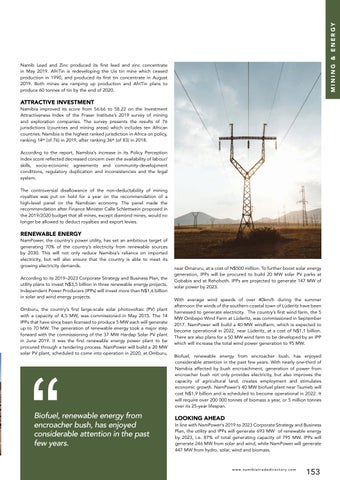MINING & ENERGY
Namib Lead and Zinc produced its first lead and zinc concentrate in May 2019. AfriTin is redeveloping the Uis tin mine which ceased production in 1990, and produced its first tin concentrate in August 2019. Both mines are ramping up production and AfriTin plans to produce 60 tonnes of tin by the end of 2020.
ATTRACTIVE INVESTMENT
Namibia improved its score from 56.66 to 58.22 on the Investment Attractiveness Index of the Fraser Institute’s 2019 survey of mining and exploration companies. The survey presents the results of 76 jurisdictions (countries and mining areas) which includes ten African countries. Namibia is the highest ranked jurisdiction in Africa on policy, ranking 14th (of 76) in 2019, after ranking 36th (of 83) in 2018. According to the report, Namibia’s increase in its Policy Perception Index score reflected decreased concern over the availability of labour/ skills, socio-economic agreements and community-development conditions, regulatory duplication and inconsistencies and the legal system. The controversial disallowance of the non-deductability of mining royalties was put on hold for a year on the recommendation of a high-level panel on the Namibian economy. The panel made the recommendation after Finance Minister Calle Schlettwein proposed in the 2019/2020 budget that all mines, except diamond mines, would no longer be allowed to deduct royalties and export levies.
RENEWABLE ENERGY
NamPower, the country’s power utility, has set an ambitious target of generating 70% of the country’s electricity from renewable sources by 2030. This will not only reduce Namibia’s reliance on imported electricity, but will also ensure that the country is able to meet its growing electricity demands. According to its 2019–2023 Corporate Strategy and Business Plan, the utility plans to invest N$3,5 billion in three renewable energy projects. Independent Power Producers (IPPs) will invest more than N$1,6 billion in solar and wind energy projects. Omburu, the country’s first large-scale solar photovoltaic (PV) plant with a capacity of 4,5 MW, was commissioned in May 2015. The 14 IPPs that have since been licensed to produce 5 MW each will generate up to 70 MW. The generation of renewable energy took a major step forward with the commissioning of the 37 MW Hardap Solar PV plant in June 2019. It was the first renewable energy power plant to be procured through a tendering process. NamPower will build a 20 MW solar PV plant, scheduled to come into operation in 2020, at Omburu,
Biofuel, renewable energy from encroacher bush, has enjoyed considerable attention in the past few years.
near Omaruru, at a cost of N$500 million. To further boost solar energy generation, IPPs will be procured to build 20 MW solar PV parks at Gobabis and at Rehoboth. IPPs are projected to generate 147 MW of solar power by 2023. With average wind speeds of over 40km/h during the summer afternoon the winds of the southern coastal town of Lüderitz have been harnessed to generate electricity. The country’s first wind farm, the 5 MW Ombepo Wind Farm at Lüderitz, was commissioned in September 2017. NamPower will build a 40 MW windfarm, which is expected to become operational in 2022, near Lüderitz, at a cost of N$1,1 billion. There are also plans for a 50 MW wind farm to be developed by an IPP which will increase the total wind power generation to 95 MW. Biofuel, renewable energy from encroacher bush, has enjoyed considerable attention in the past few years. With nearly one-third of Namibia affected by bush encroachment, generation of power from encroacher bush not only provides electricity, but also improves the capacity of agricultural land, creates employment and stimulates economic growth. NamPower’s 40 MW biofuel plant near Tsumeb will cost N$1,9 billion and is scheduled to become operational in 2022. It will require over 200 000 tonnes of biomass a year, or 5 million tonnes over its 25-year lifespan.
LOOKING AHEAD
In line with NamPower’s 2019 to 2023 Corporate Strategy and Business Plan, the utility and IPPs will generate 693 MW of renewable energy by 2023, i.e. 87% of total generating capacity of 795 MW. IPPs will generate 246 MW from solar and wind, while NamPower will generate 447 MW from hydro, solar, wind and biomass.
w w w. n a m i b i a t r a d e d i r e c t o r y. c o m
153
